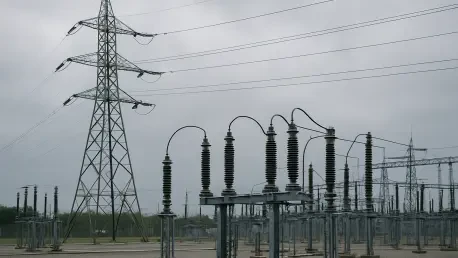In an era where the U.S. grid is pushed to its limits by soaring energy demands from AI data centers and the rapid expansion of electric vehicle (EV) charging networks, a quiet revolution is underway with the emergence of innovative solutions. Traditional energy storage systems often fall short, struggling to balance rapid response needs with long-term capacity, but hybrid flywheel-battery systems are changing the game. Enter hybrid flywheel-battery systems—a cutting-edge approach that marries the instantaneous power of flywheels with the sustained energy delivery of batteries. This powerful combination is emerging as a critical tool for maintaining grid stability amid unprecedented challenges. Far from being just a theoretical concept, these systems are already demonstrating their value in real-world applications, from educational facilities to commercial infrastructure. By addressing both immediate power fluctuations and prolonged energy needs, hybrids offer a scalable and resilient solution. This exploration delves into how such technology is reshaping energy infrastructure and why it holds the key to a more reliable grid future.
Harnessing Synergy for Superior Performance
The brilliance of hybrid systems lies in their ability to combine complementary strengths. Flywheels are exceptional at managing rapid power fluctuations, such as frequency regulation and voltage spikes, delivering near-instantaneous responses with remarkable durability. On the other hand, batteries—especially lithium iron phosphate (LFP) variants—are built for long-duration energy storage, capable of sustaining power over extended periods. When used alone, each technology faces significant drawbacks: batteries degrade quickly under frequent cycling, while flywheels lack the capacity for prolonged outages. Together, however, they form a dynamic duo. Flywheels absorb the stress of short-term demands, shielding batteries from wear and tear, which in turn significantly extends their operational life. This synergy not only enhances overall system performance but also ensures a more robust response to the diverse challenges faced by modern grids, setting a new standard for energy storage solutions.
Beyond technical compatibility, the practical impact of this pairing is transformative. A real-world example can be seen at Waterford School in Sandy, Utah, where a hybrid system integrates with geothermal wells to manage fluctuating HVAC loads. Here, the flywheel handles immediate electrical variations, preventing battery degradation, while the battery provides reliable backup for longer durations. This installation does more than just stabilize power—it serves as a living classroom, allowing students to observe grid operations like frequency regulation in real time. Such applications highlight the dual benefit of these systems: they address critical energy needs while fostering educational opportunities about sustainable technologies. By protecting critical components from overuse and ensuring consistent performance, hybrids prove their worth in settings that demand both reliability and innovation, paving the way for broader adoption across varied environments.
Addressing Modern Grid Challenges Head-On
As the grid grapples with escalating pressures from high-demand sectors, hybrid systems emerge as a vital solution. AI data centers, which require uninterrupted power to avoid costly downtimes, and EV fast-charging stations, with their sudden spikes in energy needs, are straining infrastructure like never before. Hybrid technology steps in with a dual approach—flywheels provide clean, immediate power during grid disturbances, stabilizing operations in milliseconds, while batteries ensure sustained energy during longer load shifts or outages. This combination eliminates the need for expensive grid overhauls, offering a cost-effective way to maintain reliability. For industries where even the briefest interruption can lead to significant losses, such as AI processing, this capability is indispensable. The ability to seamlessly handle both short-term shocks and extended demands positions hybrids as a cornerstone for managing the evolving landscape of energy consumption.
Moreover, the adaptability of these systems to diverse stressors makes them uniquely suited to today’s environment. Beyond just reacting to sudden changes, they proactively support grid stability by smoothing out fluctuations that could otherwise cascade into larger disruptions. This is particularly crucial as renewable energy sources, with their inherent variability, become more integrated into the grid. Hybrids can bridge the gap during periods of low generation, ensuring a steady supply without resorting to fossil fuel backups. Their capacity to respond to both microsecond-level disturbances and hour-long deficits offers a flexibility that single-technology solutions simply cannot match. By reducing dependency on traditional infrastructure upgrades, which often take years and billions of dollars, these systems provide an agile and efficient path forward for utilities and industries facing rapid growth in energy demands, ensuring the grid remains robust under pressure.
Delivering Economic and Sustainable Advantages
From a financial perspective, hybrid systems present a compelling case for investment. While the initial cost of flywheels may be higher compared to standalone setups, their impressive 20-year lifespan, coupled with minimal maintenance and zero degradation, translates into substantial long-term savings. Standalone battery systems, by contrast, often require replacement within 8 to 10 years due to wear from high-frequency cycling. When paired with flywheels, battery life can extend to 15 or even 20 years, slashing the total cost of ownership. This economic edge is critical as the U.S. confronts staggering grid investment needs projected to exceed $1 trillion over the coming decades. By offering a more durable and cost-efficient alternative, hybrids make energy storage projects more viable, supporting utilities and businesses in meeting ambitious sustainability goals without breaking the bank.
Additionally, the economic benefits are amplified by the strategic focus on sustainability and resilience. Hybrid systems reduce the frequency of component replacements, cutting down on waste and the resource-intensive process of manufacturing new units. This aligns with broader environmental objectives, as fewer replacements mean a smaller carbon footprint over the system’s lifecycle. Furthermore, the ability to handle peak loads without additional infrastructure investment allows for better allocation of financial resources, freeing up capital for other critical grid enhancements. The longevity and reliability of hybrids also provide predictability in budgeting for energy projects, a significant advantage for planners navigating uncertain economic conditions. As the push for cleaner, more efficient energy solutions intensifies, the financial and ecological merits of these systems stand out as a practical choice for scaling up grid capabilities in a responsible manner.
Strengthening National Energy Independence
A significant advantage of hybrid systems lies in their alignment with domestic priorities for energy security. American-made LFP batteries, known for high performance and recyclability, integrate seamlessly with flywheel technology to create a solution rooted in local innovation. This reduces dependence on foreign supply chains, mitigating geopolitical risks and ensuring a steady availability of critical components. Such systems are tailored for grid services like demand response and peak shaving, delivering performance without compromise. By fostering a homegrown approach to energy storage, hybrids contribute to a more secure and independent infrastructure, supporting national goals for resilience in the face of global uncertainties. This focus on domestic manufacturing not only bolsters economic growth but also ensures that the backbone of the grid remains under local control.
Equally important is the scalability that comes with this localized strategy. As demand for reliable energy storage grows, having a robust domestic production base for both batteries and flywheels allows for rapid deployment tailored to regional needs. This is particularly relevant for supporting high-growth sectors such as AI and EV infrastructure, where customized solutions can address specific load profiles. Domestic innovation also encourages continuous improvement in technology, as proximity to end-users facilitates feedback and iteration. The result is a more adaptive energy ecosystem capable of evolving alongside emerging challenges. By prioritizing American manufacturing, hybrid systems not only enhance grid stability but also lay the groundwork for long-term self-reliance, ensuring that the nation is equipped to handle future energy demands without external vulnerabilities.
Pioneering a Stable Energy Future
Reflecting on the journey of hybrid flywheel-battery systems, their impact on grid stability becomes evident through tangible successes in diverse applications. From stabilizing school facilities with geothermal integration to supporting commercial projects under intense demand, these systems prove their mettle in balancing rapid response with enduring capacity. Their ability to mitigate the weaknesses of standalone technologies while delivering economic and environmental benefits marks a turning point in energy storage approaches. Looking ahead, the focus should shift to accelerating recognition and adoption of this technology. Policymakers and industry leaders must prioritize incentives for integrating hybrids into grid planning, while educational initiatives can amplify awareness of their potential. Investing in further research to optimize performance and reduce upfront costs will ensure broader scalability. As grid challenges persist, hybrids stand as a tested solution, ready to anchor a resilient energy landscape if given the strategic support to thrive.









